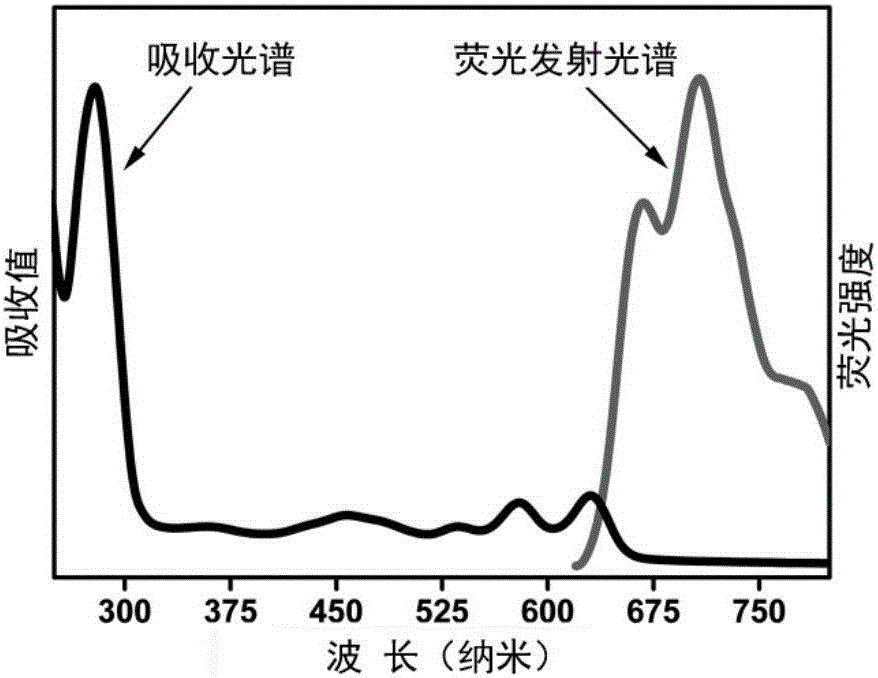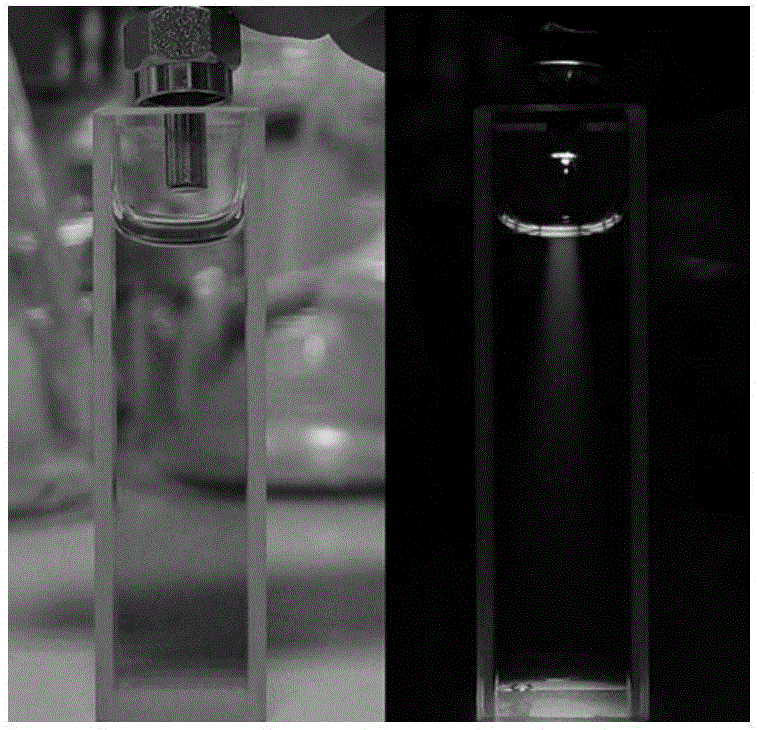Orange light and infrared emission polymer carbon nanodot and preparation method thereof
A near-infrared and polymer technology, applied in nano-carbon, nano-technology, nano-optics, etc., can solve the problems of low signal-to-noise ratio, lower resolution and sensitivity, and limit the development and application of carbon dots in live fluorescence imaging, and achieve broad Application prospect, low cost, good solubility
- Summary
- Abstract
- Description
- Claims
- Application Information
AI Technical Summary
Problems solved by technology
Method used
Image
Examples
Embodiment 1
[0020] Preparation of Near Infrared Emitting Polymer Carbon Dots
[0021] Preparation of near-infrared emitting polymer carbon dots: get 0.184g (1mmol) dopamine and 0.108g (1mmol) o-phenylenediamine, dissolve in 10mL deionized water, then add a volume fraction of 37% concentrated hydrochloric acid aqueous solution to make the reaction system The pH value of the solution is 5.3, and it is stirred evenly with a glass rod. The liquid was transferred into a polytetrafluoroethylene-lined stainless steel reaction kettle with a capacity of 20 mL, the lid of the kettle was tightened, and the reaction was carried out at 200° C. for 8 hours, and the reaction kettle was naturally cooled to room temperature. Then add absolute ethanol for ultrasonication, so that the product attached to the lining of the reactor is fully dissolved in the ethanol solution. The obtained liquid was transferred into a pear-shaped bottle, and the solvent ethanol was removed by a rotary evaporator, and then the...
Embodiment 2
[0025] Preparation of orange-red fluorescent carbon dots
[0026] Preparation of orange-red emitting polymer carbon dots: Take 0.184g dopamine and 0.108g o-phenylenediamine, dissolve them in 10mL deionized water, then add concentrated hydrochloric acid aqueous solution with a volume fraction of 37%, so that the pH of the reaction system is 5.3, Stir with a glass rod. The liquid was transferred into a 20mL polytetrafluoroethylene-lined stainless steel reaction kettle, the lid of the kettle was tightened, and the reaction was carried out at 150°C for 8 hours, and the reaction kettle was naturally cooled to room temperature. Then add absolute ethanol for ultrasonication, so that the product attached to the lining of the reactor is fully dissolved in the ethanol solution. The obtained liquid was transferred into a pear-shaped bottle, and the solvent ethanol was removed by a rotary evaporator, and then the obtained solid was vacuum-dried at 60° C. to finally obtain 0.061 g of soli...
Embodiment 3
[0029] Due to the high fluorescence quantum yield of the obtained long-wavelength polymer carbon dots, we applied them in in vivo bioimaging. We subcutaneously injected the ethanol solution of orange-red emitting polymer carbon dots obtained in Example 2 into nude mice. Depend on Figure 7 It can be clearly seen that the obtained in vivo fluorescence imaging effect is very good, and the interference of the short-wavelength fluorescence emission of the organism is well eliminated.
PUM
| Property | Measurement | Unit |
|---|---|---|
| Height | aaaaa | aaaaa |
Abstract
Description
Claims
Application Information
 Login to View More
Login to View More - R&D
- Intellectual Property
- Life Sciences
- Materials
- Tech Scout
- Unparalleled Data Quality
- Higher Quality Content
- 60% Fewer Hallucinations
Browse by: Latest US Patents, China's latest patents, Technical Efficacy Thesaurus, Application Domain, Technology Topic, Popular Technical Reports.
© 2025 PatSnap. All rights reserved.Legal|Privacy policy|Modern Slavery Act Transparency Statement|Sitemap|About US| Contact US: help@patsnap.com



